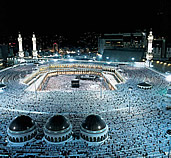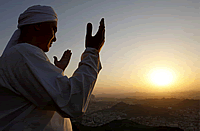


- MosqueVisiting the Mosque
History of the Mosque
Locate us - About IslamPillars of Islam
Quran about Jesus
Quran about Mary
Quran and Science - MusicSamy Yusuf
Nešidu-l-huda - Linksquran.com
1001inventions.com
harunyahya.com
might change your perception
of world(s) around us. Photo GalleryInteriour, Exteriour, Graveyard
and some other interesting photos... Featured on
KAYAK
Makkah and Hajj
|
The pilgrimage to Makkah (the hajj) is an obligation only for those who are physically and financially able to do so.
Pilgrims wear special clothes: simple garments that strip away distinctions of class and culture, so that all stand equal before God. The rites of the hajj, which are of Abrahamic origin, include going around the Ka'bah seven times, and going seven times between the hills of Safa and Marwa as did Hagar (Hajir, Abraham's wife) during her search for water.
The close of the hajj is marked by a festival, the 'Id al Adha, which is celebrated with prayers and the exchange of gifts in Muslim communities everywhere. This and the 'Id al Fitr, a festive day celebrating the end of Ramada-n, are the two holidays of the Islamic calendar.
|

100 names of which 99 names are
known. The Holy Qur'an

where you can hear the recitation
in Arabic and read the translation
in your own language. The Message

Anthony Quinn and Irene Papas
Duration: 2:58:08 EzanEzan is called out by the muezzin
in the mosque, sometimes from a
minaret, five times a day summo-
ning Muslims for mandatory (fard)
prayers (salah). Makkah and Hajj

is an obligation only for those
who are physically and financially
able to do so.


 The pilgrims later stand together on the wide plains of 'Arafat (a large expanse of desert outside Makkah) and join in prayer for God’s forgiveness, in what is often thought as a preview of the Day of Judgment.
The pilgrims later stand together on the wide plains of 'Arafat (a large expanse of desert outside Makkah) and join in prayer for God’s forgiveness, in what is often thought as a preview of the Day of Judgment.